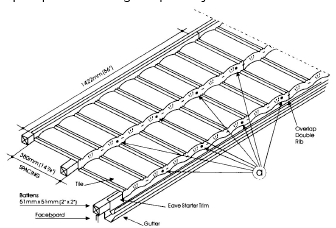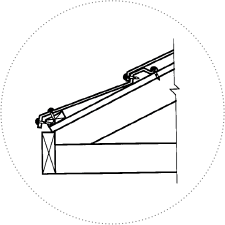 There are numerous metal shingles and metal panel products that are marketed for use as steep-slope roof coverings. These products are currently fabricated from aluminum, copper, and steel. Most of these steep-slope metal products are press-formed. Some metal shingles and panels have a fastening flange formed along the top edge. Some products have a water stop that engages the adjacent component; others do not. Some pre-coated or granule surfaced panels are formed from mild steel that has a zinc-based protective coating.
There are numerous metal shingles and metal panel products that are marketed for use as steep-slope roof coverings. These products are currently fabricated from aluminum, copper, and steel. Most of these steep-slope metal products are press-formed. Some metal shingles and panels have a fastening flange formed along the top edge. Some products have a water stop that engages the adjacent component; others do not. Some pre-coated or granule surfaced panels are formed from mild steel that has a zinc-based protective coating.
After forming some panels, the exposed surface is coated with crushed stone chips that are adhered to the panels with an acrylic-based resin or coating. With some granule- coated products, a clear acrylic-based glaze is applied to finish the top surface.
The base metals for these steep-slope metal roofing products are manufactured in the same traditional manner (e.g., stamped or roll-formed) as aluminum, copper, and steel roofing materials are produced.

 Application requirements depend on the product profile, the type of design, and the building code regulations. Some steep-slope metal shingle or panel systems are marketed for applications over spaced and solid sheathing, directly to structural framing (e.g., over metal or wood purlins), over battens and over counter-batten systems. Consult the local building code of jurisdiction and manufacturer’s requirements for roof deck or substrate requirements.
Application requirements depend on the product profile, the type of design, and the building code regulations. Some steep-slope metal shingle or panel systems are marketed for applications over spaced and solid sheathing, directly to structural framing (e.g., over metal or wood purlins), over battens and over counter-batten systems. Consult the local building code of jurisdiction and manufacturer’s requirements for roof deck or substrate requirements.
Some steep-slope metal roof systems require one layer of #30 asphalt-saturated felt as the minimum underlayment. However, with other metal systems, a layer of polyethylene sheeting is required. The product manufacturer’s recommendations for underlayment vary widely with the specific system and the climate where the product will be used.

Fasteners
Due to the wide variety of steep-slope metal roof systems, and the diversity of proprietary fastening systems, manufacturers’ requirements for specific fasteners must be consulted.
 The types of fasteners include nails, screws, and clip systems.
The types of fasteners include nails, screws, and clip systems.
Some steep-slope metal roof systems utilize concealed fasteners, where others use fasteners that are exposed to the weather.
NOTE: It is important that the fasteners be compatible with the base metal (e.g., if copper shingles, use copper or stainless fasteners, etc.).
Hips and Ridges
Most of the steep-slope metal roof system manufacturers have proprietary metal accessories that include hip and ridge coverings.
The specific steep-slope metal roofing systems manufacturer’s guidelines should be consulted. In the absence of specific manufacturer’s guidelines or recommendations, a metal saddle ridge may be appropriate for ridge coverings. With some metal systems, the metal saddle concept can be altered for use at hip coverings as well.

Granule-surfaced Metal Tiles
 Suitable for applications where the roof slope is 1:4 or greater (up to a vertical mansard or rounded roof application), the tiles may be fastened to a wood batten gridwork or directly to roof deck sheathing using epoxy-sealed
Suitable for applications where the roof slope is 1:4 or greater (up to a vertical mansard or rounded roof application), the tiles may be fastened to a wood batten gridwork or directly to roof deck sheathing using epoxy-sealed
roofing screws. The panels interlock to hold down successive courses of tiles. They are secured at the top and bottom of each panel to resist damage or panel blowoff
Steel Tiles
A steel tile roof system is composed of steel “slates” with various shapes that are attached to the roof in a multi-diamond configuration.

Suitable for application where the roof slope is 4:12 or greater (up to a vertical mansard application), it can be installed on a plywood deck or steel deck. The individual tile’s ribs interlock, aiding in the placement of the next tile. Preformed accessories are also offered which means that nothing need to be formed at the job site and no special tools are required.
Many steel tiles and panels are constructed of “galvalume” steel, which is lightweight and resistant to corrosion. Compared to industrial grade galvanized steel, “galvalume’s” resistance to corrosion is said to be two to six times greater.

Aluminum Tiles
Lightweight aluminum tiles are designed with the appearance of real hand-split cedar shakes. Rough wood grain surface textures are moulded in aluminum sheets using a 725 tonne (800 ton) press that deeply forms the aluminum in eight separate stages.
 Copper Shingles
Copper Shingles
A copper shingle is made up of 6 layers of materials. A heavyweight glass fibre mat 0.15 kg/m² (3 lb/square) acts as the base carrier giving the shingle its high mechanical and tensile characteristics. The mat is pre- impregnated with modified bitumen to completely fill all voids. The mat is then sandwiched on either side with a layer of polymer modified asphalt, sealing the mat.
Installation of Metal Tiles and Shingles
Installation depends greatly on manufacturer specifications, since the products can take so many forms and utilize a number of different fastening techniques, including clip-type fasteners, horizontal battens, rake edge sections, starter strips, and accessory items like wall flashing, gable flashing, roof penetrations, and valley pans, that become an integral part of the overall system or are dependent upon the roof’s configuration.
An underlayment is required for almost all metal tile and panel systems, usually composed of a nailed #30 asphalt felt.
In general, metal shingle systems are installed in horizontal courses starting at the eave and proceeding up the roof to the ridge. Some metal shingle systems require horizontal battens to be installed on the deck at a spacing matching the fastener row spacing of the particular system as indicated in the manufacturer’s specifications. Some systems require that the top edge of the panel be hemmed and secured beneath the bottom of the upper panel edge to support the panel, giving the ridge section uniformity and weather-tightness.

